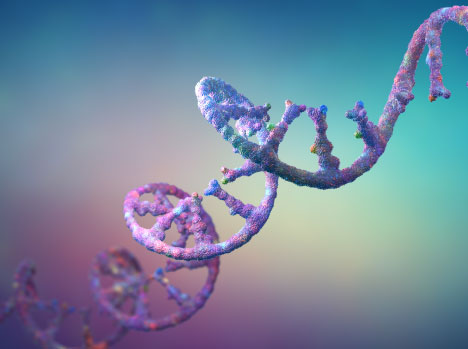A personalized mRNA-based cancer vaccine for glioblastoma with an “onion-like” delivery mechanism can prolong survival both in dogs and humans, the results of a small study have suggested.
In an article published May 1 in Cell, researchers from the University of Florida (UF) and a spinout biotech, iOncologi, shared results from seven years’ worth of experiments culminating in a first-of-its-kind phase 1 trial in four patients and 10 pet dogs who had developed brain cancer spontaneously.
The human patients survived or lived without disease for “longer than expected,” according to a press release, although it noted that it is too early in the trial to analyze the vaccine’s clinical effects. Meanwhile, the dogs lived for a median of 139 days, far longer than the typical 30- to 60-day survival time.
The findings drew the attention of Eric Topol, M.D., Ph.D., founder of the Scripps Research Translational Institute. He was not affiliated with the study.
“Glioblastomas are among the most aggressive and fatal cancers,” Topol commented in a post on X, formerly known as Twitter. “After marked success treating 10 dogs … [the vaccine] induced a striking anti-tumor response.”
The vaccine’s design is a marked departure from others of its kind. Typically, mRNA vaccines ferry their payload in lipid nanoparticles that target Toll-like receptors on immune cells, a type of receptor that activates the adaptive immune response. For most applications, like mRNA-based COVID-19 vaccines, the mRNA inside the particles is transcribed into proteins that train the immune system to react to a disease, but it isn’t targeted to a specific patient.
In contrast, the new vaccines wrap either mRNA or RNA based on a patient’s tumor in a complex of several lipid nanoparticles called RNA lipid particle aggregates (RNA-LPAs), a tactic that disguises it to look like a virus. Rather than engaging Toll-like receptors, they activate a protein called RIG-I in stromal cells, a type of stem cell found in tissues throughout the body as well as the tumor microenvironment. When injected into the bloodstream, this stimulates the release of a large number of cytokines and chemokines along with dendritic cells and lymphocytes, training the immune system to go after the patient’s cancer.
“Instead of us injecting single particles, we’re injecting clusters of particles that are wrapping around each other like onions, like a bag full of onions,” Elias Sayour, M.D., Ph.D., senior author, said in the release. “The reason we’ve done that in the context of cancer is these clusters alert the immune system in a much more profound way than single particles would.”
The strategy overcomes one of cancer vaccines’ biggest obstacles: eliciting a strong immune response, UF researchers Christina von Roemeling, Ph.D., and John Ligon, M.D., both authors on the study, explained in a separate article they penned for The Conversation. Injecting them systemically, rather than directly into the skin, muscle or tumor itself, perpetuates the effect.
“From [the bloodstream], they travel to organs throughout the body involved in the immune response to teach the body to fight against cancer,” von Roemeling and Ligon said in their article. “By doing so, we’ve found that the immune system launches a near-immediate and powerful response.”
They saw blood markers associated with immune activation within just six hours; the tumors were turned from “cold”, or impenetrable by the immune system, to “hot” within just 48 hours, according to the press release.
All that immune activity does come with the risk of side effects, the degree of which aren’t yet clear from the early studies. That’s one limitation the researchers will be on the lookout for as they move into an expanded phase 1 study that will include up to 24 pediatric and adult patients.
Once they’ve established dosing, the researchers will enroll 25 pediatric patients for phase 2. They also hope to test the vaccine alongside other immunotherapies, as early evidence from their experiments suggests a combination approach might be worth pursuing, Sayour said in the release.
“I am hopeful for how this could now synergize with other immunotherapies and perhaps unlock those immunotherapies,” he said.
https://www.fiercebiotech.com/research/glioblastoma-vaccine-turns-brain-tumors-cold-hot-humans-and-dogs

Check out our mRNA service to expedite your vaccine research
PackGene Biotech is a world-leading CRO and CDMO, excelling in AAV vectors, mRNA, plasmid DNA, and lentiviral vector solutions. Our comprehensive offerings span from vector design and construction to AAV, lentivirus, and mRNA services. With a sharp focus on early-stage drug discovery, preclinical development, and cell and gene therapy trials, we deliver cost-effective, dependable, and scalable production solutions. Leveraging our groundbreaking π-alpha 293 AAV high-yield platform, we amplify AAV production by up to 10-fold, yielding up to 1e+17vg per batch to meet diverse commercial and clinical project needs. Moreover, our tailored mRNA and LNP products and services cater to every stage of drug and vaccine development, from research to GMP production, providing a seamless, end-to-end solution.
Related News
[2024/11/22] Gene and Cell Therapy- weekly digest from PackGene
FeaturedNewsArticlesPackGene's NewsletterReceive the latest news and insights to your inbox.About PackGenePackGene Biotech is a world-leading CRO and CDMO, excelling in AAV vectors, mRNA, plasmid DNA, and lentiviral vector solutions. Our comprehensive offerings span...
Novartis seeks more bolt-on deals as it purchases neuro startup for up to $1.1B
Novartis is buying gene therapy and neuroscience biotech Kate Therapeutics in a deal worth $1.1 billion in upfront and milestone payments, the Swiss pharma confirmed to Endpoints News on Thursday. And Novartis is not done yet. It is still on the lookout for bolt-on...
Genprex Signs Exclusive License to Additional Gene Therapy Technologies with the University of Michigan for the Treatment of Lung Cancer
License includes Genprex's Reqorsa® Gene Therapy in Combination with ALK-Inhibitors for the Potential Treatment of ALK-Positive Lung Cancer AUSTIN, Texas, Nov. 20, 2024 /PRNewswire/ -- Genprex, Inc. ("Genprex" or the "Company") (NASDAQ: GNPX), a clinical-stage...
Vyriad announces strategic collaboration with Novartis to develop in vivo CAR-T cell therapies
Collaboration will combine Vyriad's lentiviral vector platform and Novartis expertise and leadership in cell therapy innovation ROCHESTER, Minn., Nov. 20, 2024 /PRNewswire/ -- Vyriad, Inc., a clinical-stage biotechnology company developing the next generation of...
Related Services

Plasmids GMP Services

AAV GMP Services


